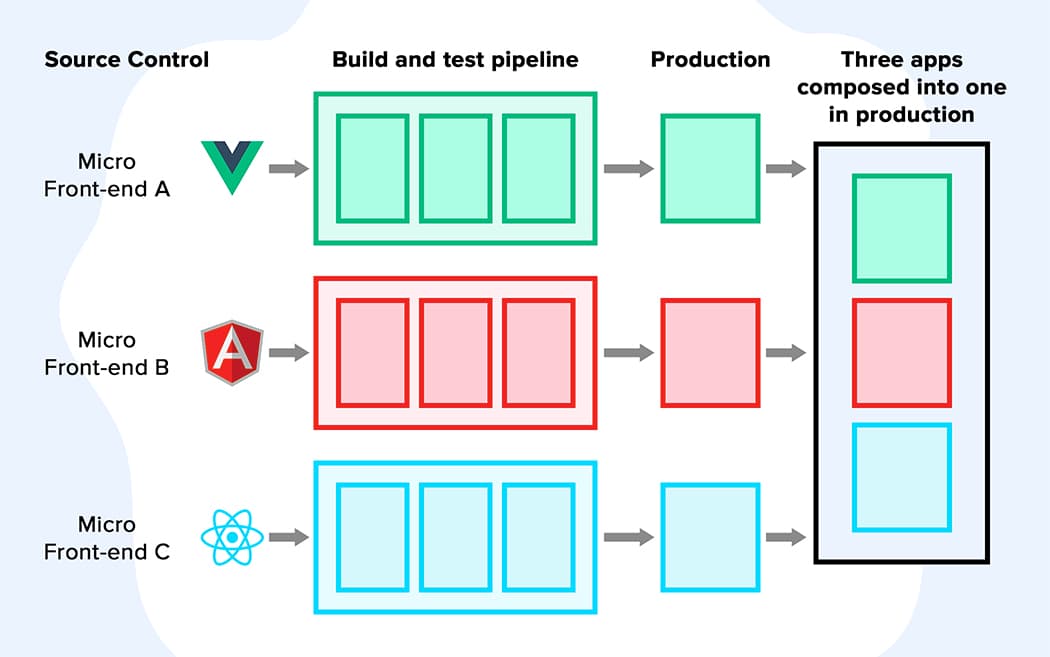Transitioning to Micro Frontends for Scalable Web Development

Micro frontends is an architectural style for building web applications that decomposes the frontend codebase into smaller, independent units called micro frontends. Each micro frontend owns a specific domain or feature area of the application, and can be developed and deployed independently.

Benefits of Micro Frontends

- Scalability: Micro frontends allow teams to scale the development and maintenance of large web applications by distributing the work across multiple independent teams.
- Modularity: Micro frontends can be independently developed and deployed, which makes it easier to maintain and update the application as needed.
- Team Collaboration: Micro frontends promote team collaboration by allowing different teams to work on different parts of the application without stepping on each other’s toes.
- Improved Performance: By isolating the frontend codebase into smaller units, micro frontends can improve the performance of the application by reducing the amount of code that needs to be loaded and executed.
Challenges of Transitioning to Micro Frontends
- Communication: Micro frontends need to communicate with each other to share data and functionality. This can be challenging to manage, especially in large and complex applications.
- Deployment: Deploying micro frontends can be more complex than deploying a monolithic frontend application, as each micro frontend needs to be deployed and managed independently.
- Testing: Testing micro frontends can be challenging, as it is important to ensure that each micro frontend works independently and does not interfere with the other micro frontends.
Best Practices for Transitioning to Micro Frontends
- Start Small: Begin by identifying a small part of the application to transition to micro frontends. This will help you get experience with the process and identify any challenges that need to be addressed.
- Use a Framework: There are several frameworks available to help you manage the development and deployment of micro frontends. These frameworks can simplify the process and reduce the risk of introducing bugs into your application.
- Communicate Early and Often: It is important to communicate with all stakeholders early in the transition process to ensure that everyone is on the same page. This will help avoid surprises and make the transition smoother.
- Test Thoroughly: Before deploying any micro frontends, it is important to test them thoroughly to ensure that they work independently and do not interfere with the other micro frontends.## Transitioning to Micro Frontends for Scalable Web Development
Executive Summary
Micro frontends offer a novel approach to web development, enabling teams to build complex applications by composing independent, reusable components. This paradigm shift drives greater scalability, flexibility, and team autonomy, allowing organizations to adapt to evolving market demands and enhance productivity.
Introduction
In today’s dynamic digital landscape, the demand for scalable, maintainable, and adaptable web applications has become paramount. Traditional monolithic architectures, while reliable, face limitations in terms of scalability and team collaboration when applications grow in size and complexity. Micro frontends emerge as a transformative solution, addressing these challenges and unlocking new possibilities in web development.
Key Benefits of Micro Frontends
Micro frontends architecture entails dividing a large web application into smaller, independent components that can be developed and maintained by separate teams. This decomposition into microservices brings about significant benefits:
-
Scalability: Micro frontends allow for independent scaling of individual components, addressing the scalability limitations of monolithic architectures.
-
Flexibility: Teams can make changes or add new features to specific components without impacting the entire application.
-
Faster Development: Specialized teams focused on specific components can lead to accelerated development and deployment cycles.
-
Improved Code Reusability: Components can be shared across multiple applications, fostering code reuse and reducing maintenance efforts.
-
Increased Team Autonomy: Separate teams responsible for specific components gain greater ownership and autonomy, promoting team collaboration and innovation.
Considerations for Micro Frontends Architecture
-
Interoperability: Components must work seamlessly together, ensuring compatibility and seamless communication across the application.
-
Shared Data Management: Establishing mechanisms to manage data sharing and consistency among various components is crucial.
-
Component Testing: Testing individual components and their interactions is vital to ensure the overall stability and reliability of the application.
-
Cross-Component Communication: Implementing robust methods for components to communicate and exchange data is essential to maintain application cohesion.
Conclusion
Micro frontends architecture offers a compelling solution for developing scalable, flexible, and maintainable web applications. By embracing this paradigm shift, organizations can unlock new levels of agility, accelerate development cycles, and enhance team productivity. While transitioning to micro frontends presents challenges, adhering to best practices and implementing sound architecture principles ensures successful implementation and reap the benefits it brings.
Keyword Tags
- Micro Frontends
- Scalable Web Development
- Monolithic Architectures
- Microservices
- Component-Based Development
